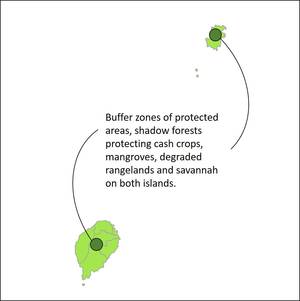São Tomé and Príncipe
The island nation of São Tomé and Príncipe (STP) is home to some of the richest and most diverse forest ecosystems in Africa. The islands’ fast-growing human population has had a significant impact on the native forests, which are largely restricted to some remote valleys and inaccessible mountain areas. Higher and increasingly competing demands for food, energy and space are accelerating the degradation of natural resources and ecosystems, which reduces their resilience to climate change.
Approximately one–third of the forests have been converted into shade plantations and agro-forestry systems that produce mostly coffee and cocoa, the country’s key export crops. STP faces the typical handicaps of a small island economy: high vulnerability to external shocks, the inability to pursue economies of scale, lack of basic infrastructure and services, low human capacity, and a weak private sector.
One of the greatest environmental threats is the over-exploitation of forest resources. Fuelwood consumption is very high, and wood is still the main commodity used in the local house construction sector. The deforestation of steep mountain slopes to plant crops and meet the national food demand is increasing the incidence of erosion and further degrading the forest.
The government of STP has identified forest and landscape restoration (FLR) as a strategic priority for the coming years, together with the fight against illegal tree harvesting, and the need to spread awareness-raising measures. Two natural parks were created in 2006, extending to both islands and including all types of terrestrial ecosystems. Unfortunately, the lack of financial resources is a serious drawback to the effective functioning of the protected areas.

IMPACTS
The project "Supporting Landscape and Livelihoods Resilience in Sao Tomé & Principe" under The Restoration Initiative (TRI) implemented by the Food and Agriculture Organization of the United Nations (FAO), the International Union for Conservation of Nature (IUCN) and United Nations Environment Programme (UNEP) has the objective of promoting the restoration and sustainable management of forest ecosystems of São Tomé and Príncipe to reduce carbon emissions from deforestation, and stop and reverse forest and soil degradation.
The project focuses on four interlinked components including policy and advocacy, capacity development, knowledge management, and the development of partnerships to harness domestic public financing structures, designing new financial products to support landscape restoration activities and achieve a more conductive environment for FLR financing.
With the support of FAO’s Forest and Landscape Restoration Mechanism (FLRM), restoration actions will target a wide range of ecosystems, including native forests with different degrees of degradation in the buffer zones of the protected areas that span approximately one-third of both islands, mangroves, and shadow forests that are critical for the cultivation of cash crops such as organic and high-quality cocoa, coffee, pepper and vanilla. In total, some 35 500 hectares (ha) of forest and agroforestry landscapes will be directly targeted with a broad range of interventions and management techniques.

